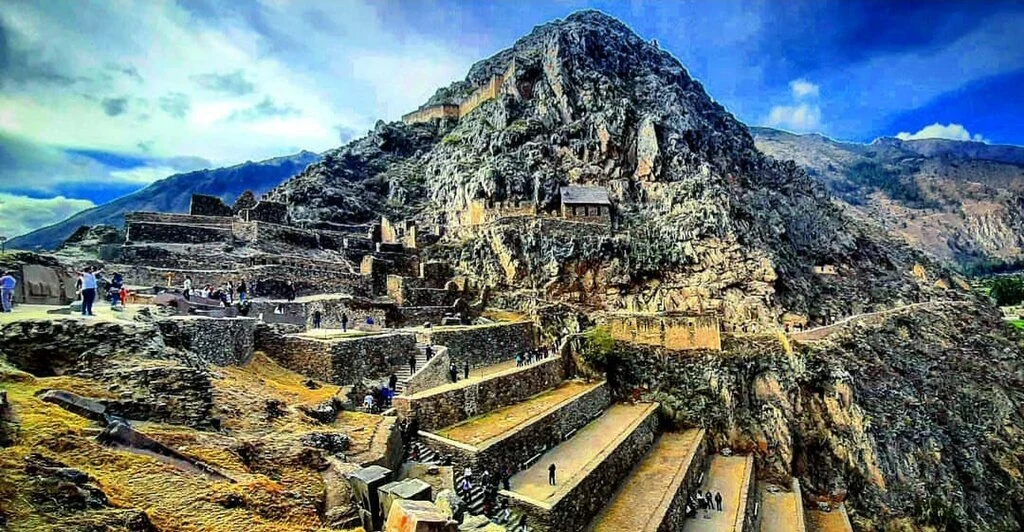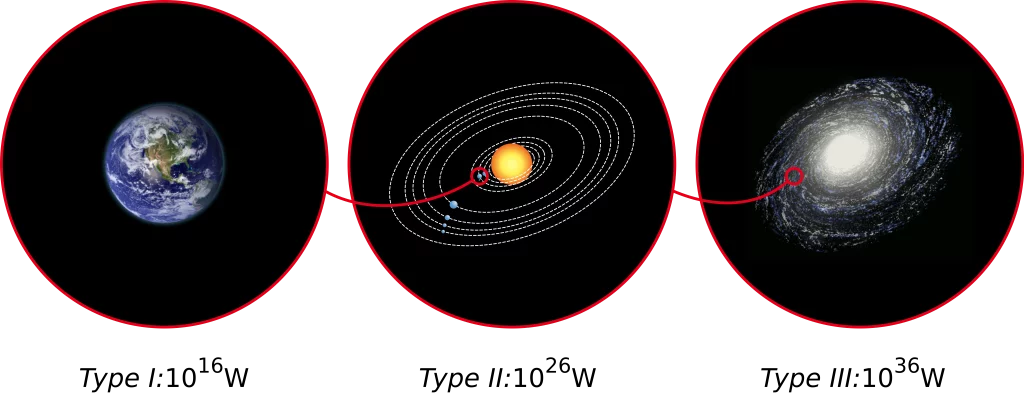Understanding Energy and Civilization

In the quest to measure and understand the progress of civilizations, the Kardashev Scale provides a valuable framework. This scale, developed by the Soviet astronomer Nikolai Kardashev in 1964, assesses a civilization’s level of technological advancement based on its energy utilization capabilities. It delves into the fundamental relationship between energy and civilization.
What is the Kardashev Scale?
The Kardashev Scale categorizes civilizations into three distinct types based on their energy consumption and utilization abilities. This scale serves as a yardstick to gauge a civilization’s ability to harness and manipulate energy in increasingly advanced ways.
The Three Types of Civilizations
Type I Civilization: A Type I civilization represents a planetary civilization capable of harnessing and utilizing the entirety of its home planet’s energy resources. This level of civilization has harnessed renewable energy sources and has the ability to sustainably meet the energy needs of its population.
Type II Civilization: A Type II civilization reflects a civilization that has progressed to harnessing the energy output of its host star. By constructing megastructures like Dyson spheres or using other advanced energy-capturing technologies, a Type II civilization can harness a significant portion of a star’s energy.
Type III Civilization: At the highest end of the scale, a Type III civilization is capable of harnessing energy on a galactic scale. This type of civilization can tap into the energy emitted by multiple stars and even entire galaxies. Their energy utilization extends to a cosmic level, enabling them to traverse vast distances and explore the universe.
By categorizing civilizations into these three types, the Kardashev Scale provides a framework for understanding the progression of civilizations in terms of their energy usage and technological capabilities. It opens up possibilities for contemplating the future of our own civilization and the potential
advancements that lie ahead. The Kardashev Scale offers a way to envision the growth and potential of civilizations as they evolve and expand their energy utilization.
As we delve further into the intricacies of the Kardashev Scale, we will explore each type of civilization in more detail. This includes discussing the defining characteristics, technological achievements, and examples of civilizations that fall into each category. By examining these types, we can gain a deeper understanding of the different levels of technological prowess and energy mastery that civilizations might attain.
Understanding the Kardashev Scale not only provides us with a fascinating glimpse into the potential future of our own civilization but also sparks curiosity about the existence of other advanced civilizations in the vast cosmos. It encourages us to contemplate our place in the universe and the possibilities that await us as we continue to advance technologically.
Stay tuned as we embark on this journey through the Kardashev Scale, unraveling the mysteries of energy and civilization, and discovering the incredible potential that lies within our grasp.
Type I Civilization: Harnessing Planetary Energy
A Type I civilization on the Kardashev Scale represents a civilization that has achieved mastery over its home planet’s energy resources. Here, we will delve into the characteristics and examples of a Type I civilization, showcasing the remarkable achievements made at this level of technological advancement.

The Characteristics of a Type I Civilization
A Type I civilization exhibits several key characteristics that set it apart in terms of energy utilization and technological capabilities:
- Renewable Energy Utilization: Type I civilizations predominantly rely on renewable energy sources such as solar, wind, hydroelectric, and geothermal power. They have harnessed the natural energy flows of their planet to meet their energy needs sustainably.
- Planetary-Scale Infrastructure: These advanced civilizations have developed extensive infrastructure networks to harness, distribute, and manage energy resources efficiently. This includes advanced power grids, energy storage systems, and smart infrastructure technologies.
- Environmental Consciousness: Type I civilizations prioritize environmental sustainability and strive to minimize their impact on the planet. They implement eco-friendly practices and technologies to reduce pollution, conserve resources, and preserve the ecosystem.
- Global Communication and Collaboration: With advanced technologies and interconnected networks, Type I civilizations have established global communication systems that enable seamless information exchange and collaboration across the planet.
Examples of Type I Civilizations
While we have yet to achieve Type I status on Earth, there are speculative examples of civilizations that could be classified as Type I:
- Ancient Civilizations: Some ancient civilizations, such as the Roman Empire or the Han Dynasty in China, achieved significant technological and cultural advancements for their time. While they did not harness planetary energy on the scale of a Type I civilization, they serve as examples of progress in human civilization.
- Future Earth: Projections for the future suggest that humanity has the potential to evolve into a Type I civilization. As we continue to advance technologically and harness renewable energy sources, such as solar and wind power, we inch closer to Type I status. Future Earth could potentially achieve global energy sustainability, advanced infrastructure, and a heightened focus on environmental preservation.
Remember, the concept of a Type I civilization is speculative, and no confirmed examples currently exist. However, by studying the characteristics and possibilities of Type I civilizations, we can envision a future where humanity attains mastery over planetary energy resources.
Stay tuned as we explore the next levels of civilizations on the Kardashev Scale, each representing even greater energy utilization and technological capabilities.
Type II Civilization: Harnessing Stellar Energy
A Type II civilization on the Kardashev Scale represents a civilization that has achieved mastery over the energy output of its host star. Let’s delve into the characteristics and examples of a Type II civilization, showcasing the awe-inspiring advancements made at this level of technological development.

The Characteristics of a Type II Civilization
A Type II civilization exhibits several distinct characteristics that set it apart in terms of energy utilization and technological capabilities:
- Dyson Sphere or Stellar Engineering: The hallmark of a Type II civilization is the ability to construct megastructures like Dyson spheres or use other advanced technologies to harness a significant portion of a star’s energy. These structures encapsulate the star, capturing and utilizing its energy output efficiently.
- Vast Energy Harnessing Capabilities: Type II civilizations can harness a colossal amount of energy from their host star, enabling them to power advanced technologies, sustain large populations, and support ambitious projects on an unprecedented scale.
- Interstellar Travel Potential: With their advanced energy and technological capabilities, Type II civilizations have the potential to explore and colonize other star systems within their reach. Their energy utilization extends beyond their home star, enabling them to venture into interstellar space.
- Enhanced Scientific Knowledge: The energy mastery of Type II civilizations allows them to conduct extensive scientific research, exploring the frontiers of knowledge in various fields such as astrophysics, advanced materials, and advanced computing.
Examples of Type II Civilizations
While no confirmed examples of Type II civilizations currently exist, there are speculative examples that capture the imagination:
- Kardashev’s Hypothetical Civilization: Nikolai Kardashev himself proposed the concept of Type II civilizations. Although purely theoretical, this civilization represents the pinnacle of stellar energy harnessing and technological advancement.
- Advanced Alien Civilizations: Speculations about extraterrestrial life often envision advanced civilizations capable of harnessing the energy of their host stars. These hypothetical advanced alien civilizations, if they exist, could be classified as Type II on the Kardashev Scale.
Remember, Type II civilizations remain speculative at this stage, and no confirmed examples have been discovered. However, by exploring the characteristics and possibilities of Type II civilizations, we can expand our understanding of the potential advancements and capabilities that may await us in the future.
Stay tuned as we delve into the final level of civilizations on the Kardashev Scale, Type III civilizations, which harness energy on a galactic scale and open up even more extraordinary possibilities.
Type III Civilization: Tapping into Galactic Energy
A Type III civilization on the Kardashev Scale represents the pinnacle of energy mastery, harnessing energy on a galactic scale. Let’s explore the fascinating characteristics and examples of Type III civilizations, showcasing their extraordinary achievements in technological advancement.

The Characteristics of a Type III Civilization
A Type III civilization exhibits remarkable characteristics that distinguish it as a galactic powerhouse of energy utilization and technological prowess:
- Galactic Energy Harvesting: Type III civilizations have developed the ability to tap into and harness the energy emitted by multiple stars, star clusters, or even entire galaxies. They have mastered the means to capture and utilize vast amounts of energy from cosmic sources.
- Interstellar Travel: With their advanced energy capabilities, Type III civilizations possess the potential to explore and traverse the vast expanses of interstellar space. They can harness enough energy to propel their spacecraft and enable efficient interstellar travel.
- Advanced Technology and Knowledge: Type III civilizations possess an incomprehensible depth of scientific and technological knowledge. They have made groundbreaking discoveries in fields such as physics, astrophysics, engineering, and advanced computing.
- Cosmic-Scale Projects: These civilizations have the ability to undertake grandiose projects on a cosmic scale. This may include constructing megastructures like Dyson swarms or even manipulating celestial bodies and resources for their needs.
Examples of Type III Civilizations
While no confirmed examples of Type III civilizations exist, speculative examples capture the imagination:
- Kardashev’s Vision: Nikolai Kardashev, the creator of the scale, envisioned Type III civilizations as the epitome of energy mastery. These hypothetical civilizations would harness energy from numerous sources within their galaxy, exhibiting unimaginable technological capabilities.
- Science Fiction Inspirations: Many science fiction works, such as the “Culture” series by Iain M. Banks, depict advanced civilizations that could be considered Type III on the Kardashev Scale. These imaginative works explore the concept of civilizations that have harnessed galactic-scale energy and showcase the extraordinary possibilities that such civilizations could achieve.
Remember, Type III civilizations remain purely speculative, and no confirmed examples have been discovered. However, by delving into the characteristics and examples of Type III civilizations, we can expand our understanding of the boundless potential of advanced civilizations in the universe.
Stay tuned as we wrap up our exploration of the Kardashev Scale, reflecting on the implications of these advanced civilizations and their implications for the future of technology and exploration.
